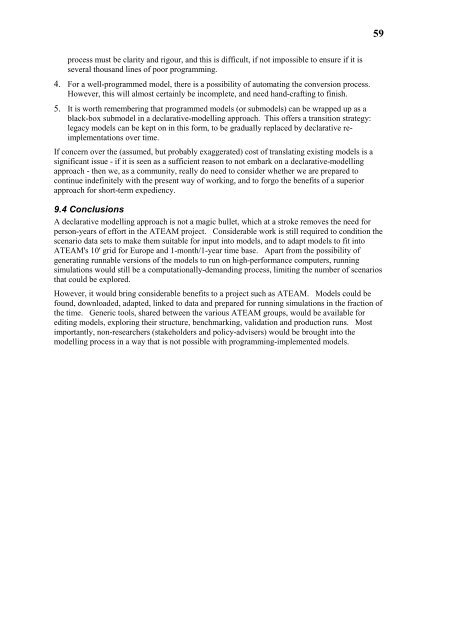pdf: 600KB - Potsdam Institute for Climate Impact Research
pdf: 600KB - Potsdam Institute for Climate Impact Research
pdf: 600KB - Potsdam Institute for Climate Impact Research
You also want an ePaper? Increase the reach of your titles
YUMPU automatically turns print PDFs into web optimized ePapers that Google loves.
59<br />
process must be clarity and rigour, and this is difficult, if not impossible to ensure if it is<br />
several thousand lines of poor programming.<br />
4. For a well-programmed model, there is a possibility of automating the conversion process.<br />
However, this will almost certainly be incomplete, and need hand-crafting to finish.<br />
5. It is worth remembering that programmed models (or submodels) can be wrapped up as a<br />
black-box submodel in a declarative-modelling approach. This offers a transition strategy:<br />
legacy models can be kept on in this <strong>for</strong>m, to be gradually replaced by declarative reimplementations<br />
over time.<br />
If concern over the (assumed, but probably exaggerated) cost of translating existing models is a<br />
significant issue - if it is seen as a sufficient reason to not embark on a declarative-modelling<br />
approach - then we, as a community, really do need to consider whether we are prepared to<br />
continue indefinitely with the present way of working, and to <strong>for</strong>go the benefits of a superior<br />
approach <strong>for</strong> short-term expediency.<br />
9.4 Conclusions<br />
A declarative modelling approach is not a magic bullet, which at a stroke removes the need <strong>for</strong><br />
person-years of ef<strong>for</strong>t in the ATEAM project. Considerable work is still required to condition the<br />
scenario data sets to make them suitable <strong>for</strong> input into models, and to adapt models to fit into<br />
ATEAM's 10' grid <strong>for</strong> Europe and 1-month/1-year time base. Apart from the possibility of<br />
generating runnable versions of the models to run on high-per<strong>for</strong>mance computers, running<br />
simulations would still be a computationally-demanding process, limiting the number of scenarios<br />
that could be explored.<br />
However, it would bring considerable benefits to a project such as ATEAM. Models could be<br />
found, downloaded, adapted, linked to data and prepared <strong>for</strong> running simulations in the fraction of<br />
the time. Generic tools, shared between the various ATEAM groups, would be available <strong>for</strong><br />
editing models, exploring their structure, benchmarking, validation and production runs. Most<br />
importantly, non-researchers (stakeholders and policy-advisers) would be brought into the<br />
modelling process in a way that is not possible with programming-implemented models.
















